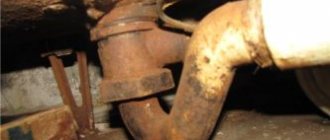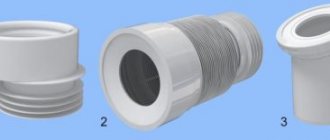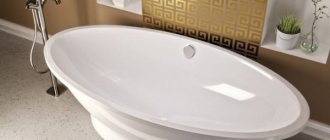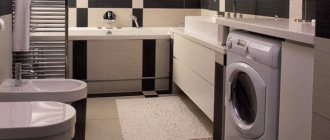Repair and decoration
04/03/2018 Anastasia Prozheva
A washing machine in the bathroom is a necessary thing in the house, because it helps save time and effort on washing. For normal operation of the machine, it must be properly connected to the water supply and sewerage system. You can install a washing machine without calling a specialist; you just need to read some recommendations. If you completely adhere to them, then installing the washing machine will not take much time. Before installing the equipment, you should purchase a siphon, because it acts as a hydraulic seal.
Purpose
Many people believe that the main purpose of the siphon, which is used to connect a washing machine, is to drain water. But this device is also intended for other purposes:
- The siphon ensures proper operation of the sewer system using a water barrier. This allows you to forget about unpleasant odors in the room where the machine is installed. Many consumers don't pay attention to this feature until sewer odors enter their home. Replacing the siphon will help solve the problem.
- The device collects all small debris and parts that enter the system during washing and prevents them from entering the sewer pipes. The siphon allows you to prevent clogging of the sewer system, since regular cleaning of pipes is quite problematic. Sometimes it is simply impossible to use chemicals to clean pipes, since the material of the pipes itself can be damaged. Some models of washing machines have a separate compartment that collects all the dust, wool and small objects. But if the model does not have this storage device, then the main load goes entirely to the siphon.
- To facilitate the operation of the washing machine pump , bends in the drain hose are used.
Which siphon should I take?
Consultants in the plumbing departments can help in selecting drain fittings. You can figure out this issue yourself, because there are no difficulties here. There are only three types of siphons: external, internal and combined.
Each siphon has its own characteristics. To understand which “knee” to choose, it is better to understand in more detail the advantages and disadvantages of each.
External drain fittings are used if the washing machine is sufficiently distant from the sewer pipe. In this case, you can install a structurally simple siphon, which will not be distinguished by its small size and additional technical delights. The main disadvantage of such products is the inability to move the washing machine close to the wall. That is why the outer “knee” is placed when this nuance is unimportant.
Internal siphons are compact; they are mounted directly into the wall, in special recesses. They are used when it is important to place the machine exactly close to the desired surface. Also, such fittings, unlike standard ones, do not spoil the appearance of the bathroom and will fit into any interior. The body of the structure is hidden behind a decorative panel, which is made of plastic or metal. Therefore, after installation, only the compact fitting of the product remains in a visible place.
The disadvantage of the internal siphon is the complexity of installation and the high cost of the product, compared to the external structure. Also, the “elbow” will not be easy to remove and clean if the drain system is clogged.
Combined siphons have several fittings, which allows you to simultaneously organize the connection of drain hoses from different devices.
Apart from this point, the reinforcement does not have any differences from the external one. The fact that the “knee” is equipped with several outputs can be very convenient in certain situations. Using a combined siphon, it is possible not only to connect the hose from the washing machine, but also to organize the drainage of water from the sink and dishwasher. Buyers most often prefer this most versatile product.
Kinds
The presence of a siphon ensures good drainage of water, extends the life of the washing machine and helps to avoid possible problems that arise from sewer blockages.
Choosing a suitable siphon is quite simple, since there are only two types of this device on the plumbing equipment market.
Combined
Use in any room. It allows water to be drained from the sink, and an additional pipe ensures a reliable connection of the automatic machine to the sewer system.
Related article: Corrugated pipe for laying cables and wires
Separate (external and built-in)
- A separate siphon is often used to connect an automatic washing machine. It can be external or built-in.
- The external siphon is characterized by small dimensions, but requires more space than the built-in element, which makes it difficult to install the machine near the wall. It is attached to the sewer pipe using an O-ring.
- a built-in siphon “boxed”; it requires less space than an external one. It is completely hidden in the wall, only an invisible pipe remains. Using the built-in siphon, you can install the washing machine tightly to the wall. Installation of this device is very simple, but you only need to prepare a special recess in the wall in advance. This variety is in great demand among buyers, because it carries out a hidden automatic discharge of water from the machine. First, the walls are tiled, and then the siphon is installed in the recess.
Description of the device and operating principle
Siphons are considered useful accessories that help reduce the load on pumps. In addition, they eliminate many of the hassles associated with system maintenance.
Structurally, the device is designed to form a so-called water seal. That's why experts say that this is a really necessary detail.
At its core, a siphon looks like a pipe with a curved channel. A certain amount of liquid is used inside, due to which the escape of gases after draining is completely prevented. The water plug prevents excess particles from getting inside the main parts of the system.
It is now difficult to imagine connecting washing machines to a drainage system without the use of siphons. These same devices make it possible to connect other equipment such as sinks, showers, and so on.
The devices are made of plastic, because it is protected from rust even when exposed to moisture. Brass and copper are also used, but less frequently.
The nuances of connecting a washing machine to the drain
Before purchasing a certain machine model, you must first read the instructions in the instructions to determine what water pressure should be to operate the product.
If the apartment is located on the upper floors, then it is necessary to check that the height difference and the storage tank can create the required pressure. On the lower floors this problem is completely absent.
Sometimes difficulties arise when connecting an automatic machine to a drain due to its location.
There are several connection methods:
- directly to the bath;
- to the siphon, which is located under the sink or sink;
- to the sewer pipe.
To connect the machine directly to the bathtub, only a hose is used, as well as a holder on the side of the bathtub. These devices are sold complete with equipment.
To connect a siphon for draining an automatic machine to a sink, you need to purchase a model with a special pipe. To connect to the pipe, a hose from the machine is connected and secured with seals.
The last mounting option, which is made to a sewer pipe, is more complex, but is also often used.
When connecting the machine to the siphon, you should pay attention to two nuances:
- The drain must be connected at a height of about 60 cm to reduce the load on the functioning of the pump.
- It is not recommended to extend the drain hose so as not to create additional stress on the pumping system. If the length is not enough, then this problem can be solved by using an additional sewer tube, the diameter of which will be only 3.2 cm. First, the pump will push water through the hose, and then it will flow randomly through the additional tube. If you decide to extend the hose, be sure to secure it at the required height, rather than throwing it on the floor, and make the right angle for good water drainage.
Related article: Programs for calculating lighting
Preparing to purchase fittings
The main thing when choosing a device is to ensure a comfortable washing process.
Dimensions of siphon M0401.
From other recommendations:
- The type of equipment does not matter if the siphon is installed so that it is not visible from behind the bathtub, door, furniture, etc.
- Hidden installation of drain fittings allows you to make the sanitary room attractive. If you are buying equipment for a sink and the siphon will be located under it, then it is better to install a flat model, since it takes up less space.
- If waste water is drained from several pieces of equipment at once through a siphon, then installing a combined device is considered a suitable option. It has the required number of fittings to connect several drain hoses at once.
- If the design of the washing machine does not provide a check valve, it must be purchased separately.
You cannot skimp on the quality of equipment and its components.
Installation steps
Connection to sewer pipes occurs in several stages and depends on the material of the pipes.
If the sewerage system consists of cast iron pipes, you must:
- Remove the old siphon. Fasten a special rubber adapter to the pipe, which will allow you to connect the cast iron to the plastic.
- Use a special plastic adapter, which has the shape of an oblique tee with a diameter of 5 cm.
- Insert the rubber adapter, the dimensions of which are 5x2.4 cm, and install the drain hose.
If plastic pipes are used for sewerage in the house, the connection process is greatly simplified. It is only necessary to build in the tee, and then all the actions are performed, as when attaching an automatic machine to cast iron pipes.
What to consider during installation, additional details
When purchasing a washing machine, the kit already includes a hose, the length of which is usually 3 m, but sometimes it is 5 m. If the length of the hose is not enough, then it can be extended, but not more than 3 m, and be sure to use a polypropylene pipe with a diameter of 2 cm for connection. It’s better not to extend it, but to buy a new hose of the required length. The special pump, which is responsible for draining water from the washing machine, is one of the most expensive parts in a washing machine, so it makes sense to save it. The longer the hose, the greater the load on the pump, so its service life is reduced. Also, in an extended hose, the number of blockages in narrowing areas increases.
When installing a washing machine, two additional details must be taken into account:
- The shut-off valve is responsible for shutting off the water so that it does not flow back into the machine. Usually washing machines come with this part, but if there is no valve, then you should definitely buy one. The importance of a regular valve is that once it is closed, the water can be used for other needs. Without it, there is a high possibility of flooding the room.
- The self-tapping valve does not shut off the water. It should be installed only in cases where there are no other units connected to the riser that use water and can cause pressure drops in the water supply system.
Related article: Ready-made curtains for the living room: pros and cons
Step-by-step valve installation
Let us consider in detail the installation of a self-tapping valve for a washing machine:
- first of all, you need to attach the plate to the surface of the wall in order to install the clamp;
- after which it is necessary to place an overhead part with a rubberized gasket, after these manipulations, check the correctness of fixation and if everything is in order, you can screw it on;
- turn the valve so that it is in the closed position to prevent water from flowing in and screw it into the trim. The self-tapping valve is designed in such a way that in its penetrating part there is a cutting edge, thanks to which you can make a hole without much effort;
- After completing all the above steps, you must tighten the control nut tightly using a gas wrench. It is necessary to install the washing machine inlet hose on the branch.
After connecting the hose to the washing machine, do not forget to move the valve to the “open” operating position, which will ensure an unhindered water supply.
Features of connecting to the sink
To connect the machine to the sink, the hose should be located at a height of about 60 cm to prevent the possibility of water accidentally flowing back into the machine.
It is necessary to purchase a tee, the shape of which resembles the letter “U”, then a hose from technical equipment is installed in one hole, and in the second - for the sink. Don't forget to use a sealant when connecting the machine to the tee. Only correct connection guarantees excellent washing without interruptions.
Subtleties of choosing siphons
A small variety of siphons greatly simplifies the process of choosing a product, but still, special attention should be paid to some points:
- The country of origin directly affects the quality of the product.
- The material used to make the siphon, and the conditions in the room in which the washing machine will be installed.
- If the machine will be installed in the kitchen along with other equipment that consumes water, for example, a dishwasher or coffee machine, then the siphon must have several outlets.
- The siphon system must be solid, without cracks or other defects. Particular attention should be paid to the threads of all connections. All rubber gaskets must be the same size as the pipes.
- The technical parameters of the siphon should be decisive when choosing a siphon. Wear-resistant material guarantees a long service life and proper operation of the entire system. The best materials for making a siphon are stainless steel or polyethylene.
What is a check valve for?
All professional plumbers recommend installing a check valve for a washing machine on the drain. This is a special device that, due to its design, allows liquid to pass in one direction, but not back. A non-return valve for draining a washing machine prevents sewage from penetrating into the appliance drum when the sewer pipe is clogged or due to spontaneous draining. This inexpensive device can be a real lifesaver for expensive equipment during an emergency. There are two options for installing a check valve:
- If the washing machine is already connected through a regular siphon, then you can purchase a separate anti-siphon valve, which will reliably protect the device from the penetration of sewer water in the event of an accident.
Anti-siphon valve - If you are just planning to install a washing machine, then it is more advisable to purchase a combined siphon with an additional pipe and a check valve, which comprehensively protects both the sink and household appliances.
Please note that most functional modern washing machines are equipped by manufacturers with a built-in anti-siphon valve. But outdated or budget models often do not have such a useful device, so to install them you need to use a siphon with a check valve.











